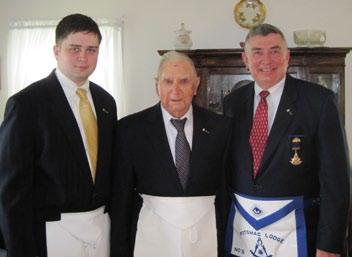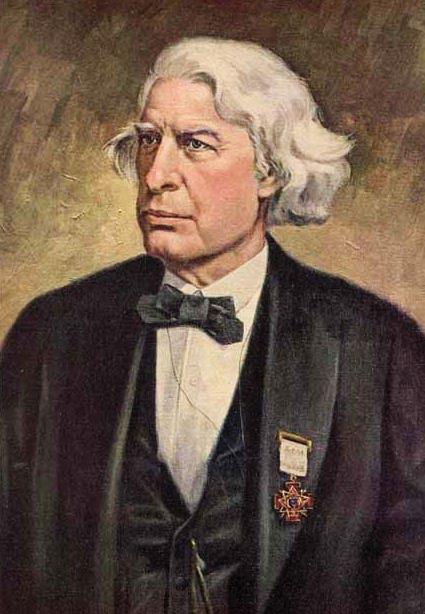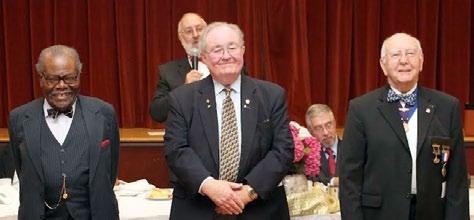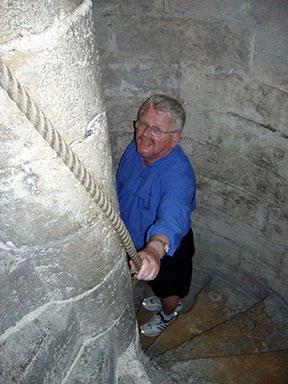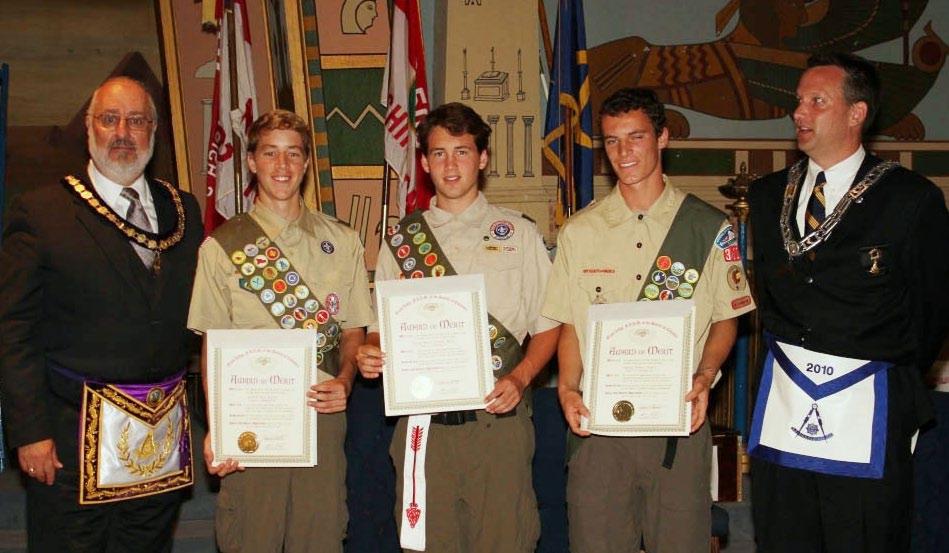
9 minute read
Engineering in Freemasonry
RWB Charbel T. Fahed, Junior Grand Steward, made the following presentation at the July 26, 2012 stated communication of Hiram Takoma Lodge, No. 10.
One of the primary motivations good men seek to join our ancient and distinguished fraternity is in order that they may learn, adopt, and exercise the principles of self-improvement, and then extend the legacy of our art to others so that they may be enabled to understand, continue, develop, and improve the building process. In order to accomplish such a magnanimous goal, it is highly recommended to draft an algorithm or a certain strategy that would empower us to achieve our dreams.
Advertisement
Our present level of achievement is, in greatest measure, attributable to what our predecessors have worked on for generations and generations.1 The technology we are currently enjoying is the product of many team interactions and integrations, those highly respected ones who worked together with harmony and dedication. Accordingly, let us ponder over the importance of team collaboration to bring forth the latent beauties of our mystic art. Technology today is very expansive and widely diverse. There is, however, a common factor: team work, which consists of various elements wherein each component is essentially important to the formation of a complete and perfect whole. The technology team consists of the following members, with a brief description of their various functions and distinctions2:
1. Scientists – They study nature in order to advance human knowledge. Although some scientists may work in industry, yet others write publications that have no immediate practical applications in life. They have a deep knowledge of mathematics and advanced degrees. 2. Engineers – They apply the law of nature and known principles and discoveries, and put them in practical use to serve a certain need in society. They are problem solvers and must have great background in mathematics and the sciences. 3. Technologists - They are normally supervised by engineers and scientists. They implement the designs and plans already established, and may sometimes alter the design to a certain extant. 4. Technicians – They accomplish specific tasks and perform the troubleshooting and repair to malfunctioning systems.
Charbel T. Fahed
Junior Grand Steward
5. Artisans – The have the manual skills and practical experience without the sophisticated mathematical background. The following is an analogy and comparison between Masonry and Engineering: • Entered Apprentices start working at an entry level position to become foremen or artisans. They begin their journey in the quarries without previous skills. They carry the burdens and do the conventional work as directed by their superiors, while, at the same time, observing and learning those first instructions from the North East corner whereon to build their future moral, and Masonic edifice.
• The Fellowcrafts are technicians who adjust and troubleshoot the imperfections of operative workmen. However, those technicians still possess limited knowledge, and operate under the directions of the master technologist who designs the work on the trestleboard.
• The Master Mason is the technologist who has the responsibility of supervising both Fellowcrafts and Entered Apprentices, or, in engineering terms, technicians and artisans. He has the task of correcting the errors and irregularities of those who work under him and are less informed.
• The Worshipful Master is the boss who instructs the Craft and distributes the work. He is the engineer who designs and lays plans on the trestleboard. As mentioned before, he is a problem solver. An engineer, unlike anyone else, cannot give up on finding a solution to a certain problem; he must tackle it and find a favorable and pleasing result that meets the satisfaction of all.
• The Grand Master should act as the deputy for the Grand Architect of the Universe, inspired and guided by Him as per the Volume of the Sacred Law to acquire the wisdom of King Solomon so
that “neither envy, discord, nor disunion should it is expected that many formulae and theorems ever exist among the Craft.” be committed to memory so that they may be The Masonic chief engineer is a trinity made of three Grand Masters consisting of Solomon, King of Israel; Hiram, King of Tyre, and Hiram Abif symbolizing wisdom, strength, and beauty. The strength or force must have a brain and a law. Thought’s force and philosophy’s energy combine applied to solve a particular problem or design a certain task. In Masonry, the ritual is our formulae and axioms that we should use in our various stations, inside and outside the lodge, reminding us to square our actions by the square of virtue towards all mankind, more especially a brother Mason. finding its aim and its effects in the amelioration The Worshipful Master sets the Craft to labor, of mankind. The power of the Deity Himself is gives them good and wholesome instruction or in equilibrium with His wisdom. Hence, the only causes the same to be done. How could this be effect is harmony. accomplished if there are no proper designs Here are specific characteristics that on the trestleboard? should exist among the members of a In Masonry, as in engineering there team, being in engineering or in any Masonic body2: Ask are some recommendations for the design process of any task, consisting • Mutual respect for the ideas of fellow team members or members of the lodge Improve of a series of steps that engineering teams use to guide them as they solve problems. This is not the Imagine • The abilresponsibility ity of team of the Master members to or officers alone, properly and relibut rather anyone, ably transmit and including sideliners, receive the ideas of should be involved when the team or the commitproper instructions and tee guidelines are adminis• The ability to lay aside distracting criticisms at the early stages of idea formation and formulation of solu tions. Create Plan tered. Anyone can do it! To determine how to build something (stadium, skyscraper, amusement park ride, bicycle, music player), engineers gather informa• The ability to build on initial or weak ideas tion and conduct research to understand the needs • The ability to pinpoint weaknesses and of the challenge to be addressed. Then they brainstrengths when doing analysis while being objecstorm many imaginative possible solutions. They tive and disinterested select the most promising idea and embark upon a design that includes drawings, and analytical deci• The patience and fortitude to try again when an sions on the materials and construction, and which idea fails initially or a solution is incomplete manufacturing and fabrication technologies to use. A great emphasis should be applied to communicaThey create and test many prototypes, making tions skills, both verbal and written. We all know improvements until the product design is good that the ritual we do in our lodges is so rich if perenough to meet their needs. formed properly; however it could be very boring The committees assigned to a certain task under and annoying if poorly delivered. In engineering, as directed by the Worshipful Master would be

wise to also follow this engineering design process. One of the best means of accomplishing this is by involving one’s self and attending the valuable officer training retreats whereby brainstorming of the multitude can result in miracles to be applied as needed to solve problems. Here are several recommendations:
• Understand the need: What is the problem? What do we want to accomplish? What are the project requirements? What are the limitations? Who is the target? What is our goal? Gather information and conduct research - talking to members of the Craft from many different backgrounds. • Brainstorm different designs: Imagine and brainstorm ideas. Be creative; build upon the wild and seemingly crazy ideas of others. Investigate existing technologies and methods to use. Explore, compare and analyze many possible solutions. • Select a design: Based on the needs identified, select the most promising idea. • Plan: Draw a diagram of your idea. How will it work? What environmental and cultural considerations will you evaluate? What materials and tools are needed? What analyses must you do? How will you test it to make sure it works? • Create: Assign team tasks. Build a prototype and test it against your design objectives. Push yourself for creativity, imagination and excellence in design. Does it work? Analyze and talk about what works, what doesn’t and what could be improved. • Improve: Discuss how you could improve your product. Make revisions. Draw new designs. Construct new versions of your design to make your product the best it can be. Here is a diagram of the cyclic process in designing the trestleboard3:
As we can see, this is an infinite iteration and we should maintain the high standards called in engineering total quality (TQ). We should not only be satisfied with what we are today and praise what we did yesterday, taking due pride in the accomplishments of our ancestors, but we should always be alert to opportunities for renovation, without violating the Ancient Landmarks of the Order. We also have to be mindful of those who disagree with us in the changes we may wish to make. For instance, I have seen major conflicts arise between the young and old. This generation gap in thinking should be carefully handled in a way that maintains respect for all concerned while always exerting the utmost effort and wisdom to find the common ground among all. What characterizes a certain society is how its members comport themselves both in the lodge and outside, in the world. The code of ethics should be highly emphasized and applied as it is the soul of the fraternity. We need a set of interaction rules outlining the expected sets of behavior between the various members. These rules can be classified as follows:

1. Etiquette – it consists of a code of behavior and courtesy. The dress code for example is a way that some particular lodge adapts to show respect to the will of the majority. Although the rules of etiquette may appear arbitrary sometimes, they were enacted with a purpose and violating such rules can draw displeasure or dissatisfaction among the rest of the community or brethren. 2. Law – it is a system of rules established by authority that represents the whole institution. Unlike etiquette, its violation can carry a penalty ranging from reprimand, to suspension, to expelling. Legal rights are given to individuals to defend themselves against claims. 3. Morals – these are expected standards of right and wrong that are usually applied to personal behavior. These morals are derived from parents, religious background, friends, and the media. Some behaviors may be argued to be either moral or immoral depending on the culture or background. For example, gambling could be a serious moral issue in some societies while it is perfectly tolerated in others.
4. Ethics – they consists of general and abstract concepts of right and wrong behavior culled from philosophy, theology, and professional societies. Because professions draw their members from different cultures and religions, their ethical standards must be secular.
As much as we would like to have a moral algorithm that always leads us to the correct answer, such an algorithm does not exist. If it did, then we could program a computer to do this job. Accordingly, conflicts happen and we have to deal with many controversies as wisely as possible. continued on page 42


